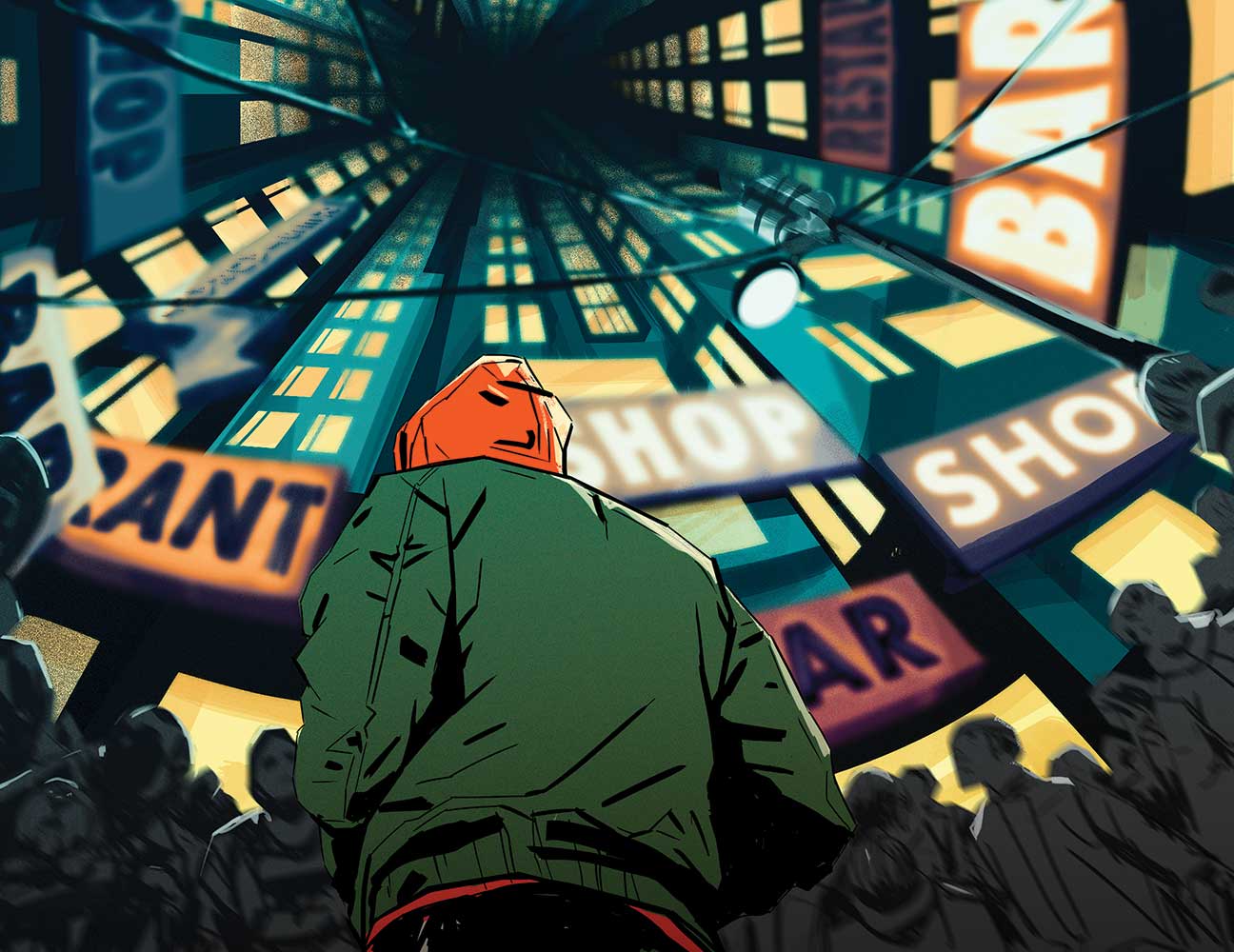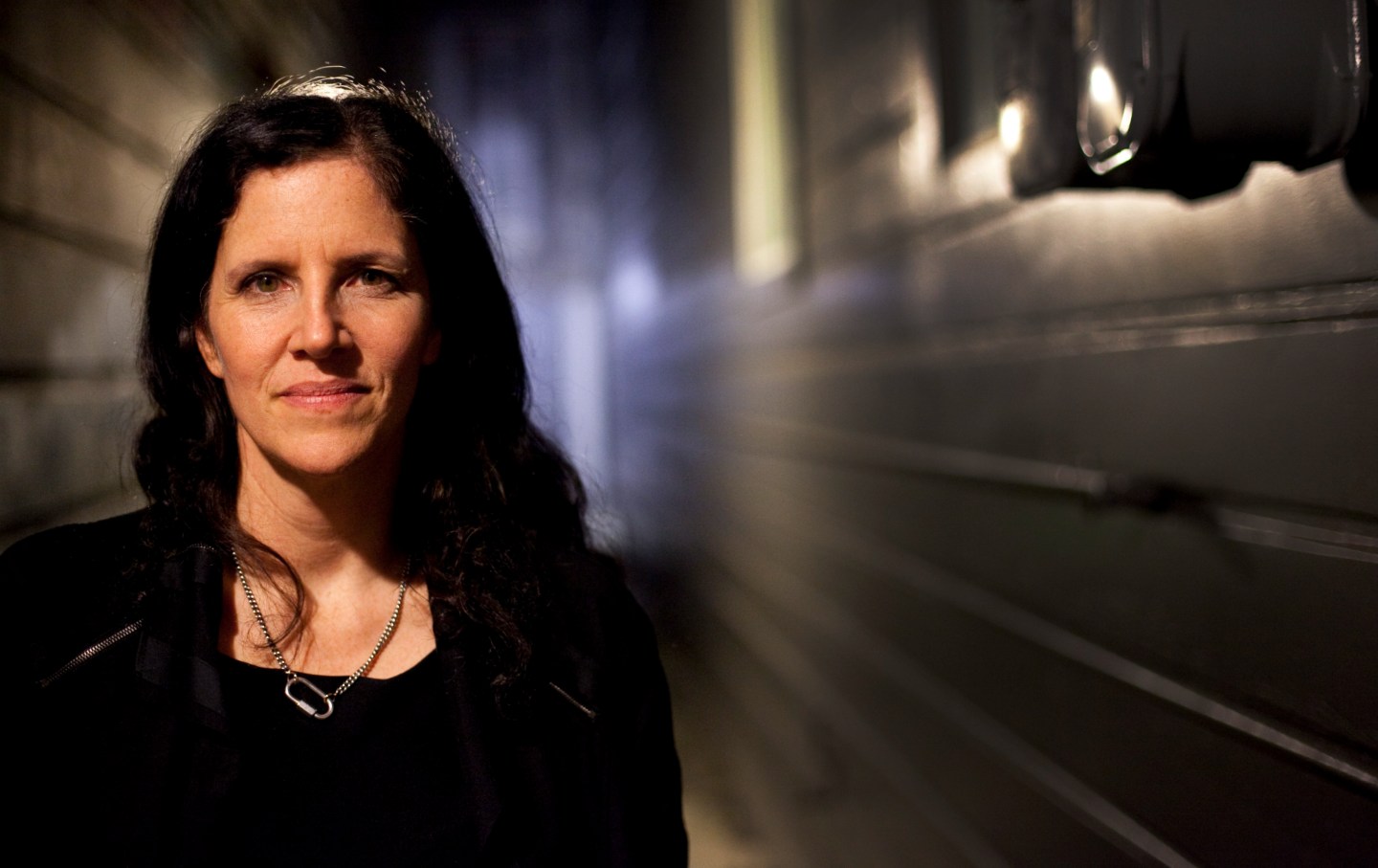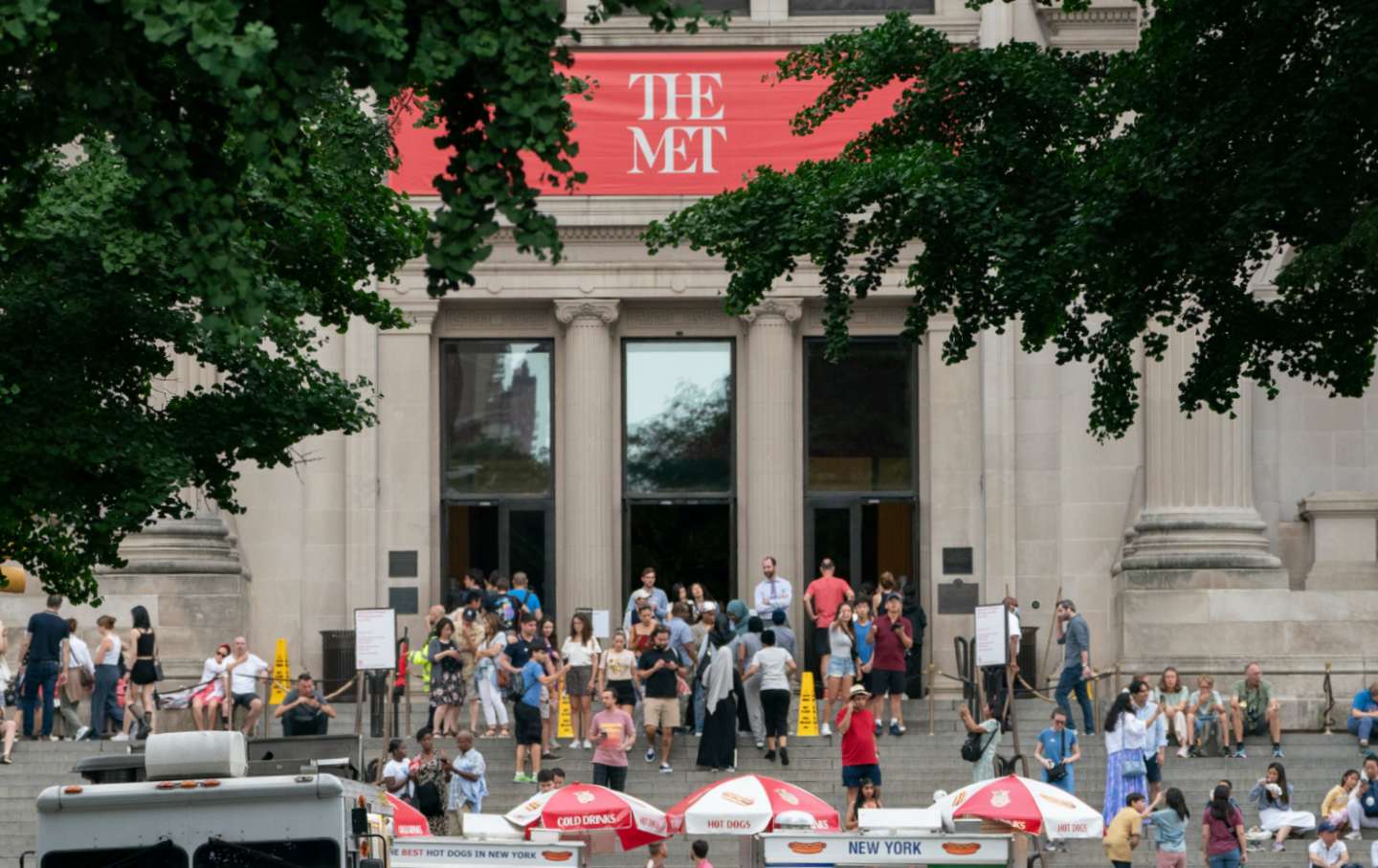A Seamless Dystopia
What happened to the 21st-century city?
What Happened to the 21st-Century City?
And how we can save it.

When I was younger, growing up in the rural but rapidly developing small town of my youth, I believed that cities were the place where one could find freedom. The greatest disappointment of my young adulthood has been the discovery that this is not true. Not only is it not true, but those glimpses of freedom I have had—freedoms that have allowed me to better understand myself and coexist with others different from me—have all been eradicated by force, whether that force was social, economic, political, or (usually) all three. In their place, we find sameness, a sameness we all complain about: the boring suburbanization of urban aesthetics that creates a miserable middle-class monoculture where every bar serves overpriced drinks and every restaurant overpriced small plates, where every store promises community and uniqueness while providing neither. And the worst part of this is that we are supposed to be happy. We are always, always, always supposed to be happy. Our neighbors disappear, and we are supposed to be happy. All the people on the street start to look the same and work at the same jobs and walk the same Labradoodles, and we are supposed to be happy. The rent goes up, and we are supposed to be happy. We are supposed to be happy because this is the city, and if you don’t like it, then you are: (a) a NIMBY on the level of the revanchist wealthy homeowners whose sole concern is for their views and their property values, (b) anti-progress, and therefore (c) you should leave.
Books in review
Smooth City: Against Urban Perfection, Towards Collective Alternatives
Buy this bookNever is it discussed that a cordoned-off, highly policed, highly regulated urban fabric of the kind that exists in every metropolitan center in the Western world is created in the image of the people who dominate that world, at the expense of those who don’t. And even if one finds oneself within these categories of dominance, be it whiteness or relative financial stability or unrestricted physical mobility, these spaces are immiserating, because they enforce a strict set of social, bodily, sexual, and behavioral norms and are driven by convenience, consumerism, and productivity. In them, we find ourselves subject to a relentless drive toward optimized, frictionless happiness, enabled by an endless array of apps and tools devoted to the task of getting someone to do your grocery shopping or find you a date. The contemporary urban end goal is a utopian world without conflict, but one that never confronts the fact that the social order that enables this utopia of commodified pleasure centers is itself produced by a lot of conflict. Little is said about how it is created by a profound and deliberate violence against all that is different, queer, unfinished, volatile, democratic, or open—in other words, all that is human.
And I know, I know, that many others feel this way: that this sadness is felt by so many people who find a place for themselves in a city and who know what it means to see their spaces of security, community, and openness taken away in exchange for more app-based deliveries, more high-end specialty shops, more cocktail bars, more apartment buildings with rents that are impossibly high. There may be no cultural name for it, and so we grasp at sociological concepts like gentrification, even though these explain only one part of the entire complex. They also cannot tell the story of the real human despair that comes in the wake of those processes, when we are supposed to be grateful to be surrounded by clean streets and people who look like us and work at similar jobs and buy similar things, but also know that this supposed harmony and equilibrium is the result of constant acts of dislocation, exploitation, police brutality, and inhumanity. And for those who question the reality of this violence, I urge you to interrogate your own happiness, your own sociality, to ask how you would feel should the places you rely on for human connection and self-expression disappear. I urge you to open up any Twitter thread about homelessness, read the replies, and tell me that what you see there is not violence. You will notice that I have not named a specific city in this exposition. I do not need to, for this condition applies to all of them.
René Boer, a longtime critic and organizer based in Amsterdam, has over the years developed a term to encompass all these different phenomena: the “smooth city.” Boer’s work at Failed Architecture has long dealt with trying to grasp the totality of what happens to cities in this rather bleak period of urban development. And in his new book, the eponymously named Smooth City, he offers a study of how vast and heterogeneous metropolises are made to look and feel the same, cater to the same clientele—a wealthy, white-collar middle class—and become seamless technocratic wholes. Through his numerous case studies from around the world and his keen eye for the sociological, Boer has produced a nuanced study of the phenomenon and experience of urban “smoothness” and its root causes.
The strength of Smooth City is found in its ability to integrate a number of different ideas, processes, and policies into one guiding framework, namely their end result: urban smoothness, homogeneity, and the eradication of anything that stands in the way. The topics in Smooth City range from the general (such as neoliberalism and its urban expressions, as well as capitalism, globalization, gentrification, militarization, commodification, real estate speculation, and class, racial, and sex-and-gender-based conflicts) to the specific (such as individual new technologies and policies that work together to reinforce ever more rigorous social norms). Boer’s research casts a wide net and avoids the common US-centric pitfalls in urbanism books. He frequently cites examples of developmental and spatial practices in cities like Amsterdam, Cairo, and London as well as New York, and he wonders (following critics such as Michael Sorkin and Rem Koolhaas in the 1990s, who wrote as this process of smoothing began) why the hell everything has to look the same—and why is that sameness so hostile?
It is not until one leaves that sameness and discovers what Boer calls “porosity,” or the opposite of smoothness, that one realizes just how smothering all this seamlessness is. This is the main task of his book, which is divided into five parts, of which the first two, “Smooth Structures” and “Smooth Origins,” are the most urgent. At the core of Boer’s thesis is a dichotomy, first represented by Reestraat in Amsterdam and King’s Cross Central in London—two sides, he argues, of the same smooth coin. Reestraat is smoothness’s historically intact, touristified, and highly branded colonization of the old, while King’s Cross Central is smoothness manufactured from scratch, with all-new buildings and a more expressly hostile urbanism.
This multiplicity of forms is what we tend to call “gentrification,” but as Boer shows, there is also a multiplicity in causes too: Gentrification is only one part of a greater system of economic and political forces that seek to exact finer and finer control over the built environment. “Nothing,” Boer writes of the smooth city, “is left undefined or allowed to gradually transform at its own pace.” Everything is governed by an urbanism oriented around “design[ating] the current and future use of every part of the city, including all the rules and regulations that come with such use,” in the pursuit of a perfect, technocratic urban whole.
In making this argument, Boer is careful to remind us that the end goal of these processes is not explicitly a smooth city; rather, the smooth city materializes because of them. It is the result of an “ongoing, collective effort by those in power, often the government and property owners, to make sure everything remains permanently ‘in perfect condition’ and nothing threatens its efficient operation.” He also notes that the smooth city, while a recent, post-globalization phenomenon, is historically based in previous concepts from urban planning, especially 19th-century renewal efforts like Haussmannization in Paris or the 20th-century modernist doctrines of urban renewal.
The particular smooth cities we see today, Boer contends, are shaped by three relatively new factors: the past four decades of neoliberal public policy, in which a retreating state or urban government rolls back things like corporate taxes, regulations, and welfare programs and rolls out pro-market policies and infrastructures; a culture of “urban revanchism,” in which newcomers to the city bring with them their suburban predilections for “quietness, cleanliness, and order in general,” and policies of increased policing and surveillance emerge to placate and attract these middle-class transplants; and, finally, new technological tools for social control, commodification, and self-surveillance that lead us to optimize ourselves, restrain ourselves for fear of punishment in the digital and real world, and trade away our privacy in exchange for technological convenience.
I would be lying if I said that my own very privileged life hasn’t been caught up in each of these developments. In Chicago’s Logan Square, the neighbors of color on my street, who had been living there far longer than I, have since been priced out. New million-dollar McMansions have replaced earlier houses split into more affordable apartments. Everything in Logan Square is almost mercilessly on brand. The bars in the neighborhood can’t just be bars along the lines of their dive predecessors, like sole survivors the Native and Bob Inn; they have to be themed experiences—photographable, commodified destinations, leading to a local pejorative for the strip: “the Uber corridor.” In a bit that’s almost too on the nose, a new franchise bar with the revolting name Federales—a notorious hot spot for the hypermasculine party practices of finance bros at its other locales—has opened up across the street from a senior center catering to Hispanic families and a popular Hispanic-owned-and-operated bar, Estereo.
The people around me in Logan Square have become, over the past decade, visually much wealthier than me. I am far more careful about what I say in public than I was when I lived in other neighborhoods, and I don’t dress as colorfully when I go to the grocery store, lest I catch the ire of strangers who increasingly fit a similar mold. One day, when I was bored, I counted the number of times a police car passed my house; that number was 13. I counted the number of times a delivery service—Amazon, UPS, FedEx, USPS, or food couriers—made an appearance; that number was 34. I am sure, deep in my heart, that whoever is reading this has experienced similar phenomena, and has found the experience bleak and depressing.
It’s worse to witness all this smoothness when you have experienced its opposite. When I left North Carolina for Baltimore in order to go to grad school, there was a remarkable and diverse art scene made up of ad hoc, quasi-legal studio spaces, venues, clubs, and bookstores the likes of which I had never experienced. I took up residence in the Copycat building, a bunch of live-in venue-apartments that were, let’s be honest, kind of grody. They were too cold in the winter and too hot in the summer, and the building was run by a questionable management company to whom the city had turned a blind eye in order to profit off the presence of artists—all part of its long quest to gentrify the space between Mount Vernon (a wealthy enclave nearer to downtown) and Charles Village (the location of Johns Hopkins University) in order to complete what Baltimore scholars call the “White L,” which now runs from the Inner Harbor up to Hopkins and bifurcates the so-called “Black Butterfly,” or the areas that have been historically marginalized based on relentless policies of racial segregation.
Imperfect as it was, the Copycat building was the first place I lived in that offered any kind of freedom—freedom to paint, to build structures, to have parties, to make mistakes, to perform, and to be around people who were staggeringly different from me. It was only through living there that I felt empowered to explore my own sexuality and my own conception of myself, my gender, and my appearance, simply because other people had the same kind of freedom, the same kind of queerness, that Boer insists is necessary to open up spaces of possibility in stifled urban environments. These spaces, Boer contends, in turn open up opportunities through which further interventions can be made, both at the interpersonal level and at the level of the social and the political. I know that freedom, that optimism, too. I know how powerful it is. I also know that whenever I find it, I soon do not have it anymore.
In 2016, after the Ghost Ship fire in Oakland, in which dozens of people died in a makeshift venue, the City of Baltimore cracked down on its ad hoc spaces in what felt like one long raid. It evicted the tenants of the Bell Foundry, another studio space. The Copycat was inundated with building inspectors and prohibited from hosting shows, which were the main source of income for many of its residents. The word “eviction” hung in the air, and beyond that, the rent was going up. The art walks that the city had previously encouraged in the area disappeared. People left, including me, for there was no longer a reason to be there and freeze to death in the winter. This pattern would be repeated over and over again in the cities I have lived in, from Ljubljana, Slovenia, to Chicago. In each case, an intolerance for messiness, stemming from the desire for profit, and the control of every square foot of land by the real estate industry to maximize that profit, are the guiding forces that undergird everything—helped, seamlessly, by those in power.
In Ljubljana, there used to be a squat in the former Rog Bicycle Factory, established back in 2006, but its inhabitants were violently evicted in 2021 during the pandemic to allow the city to develop a clean, tech-oriented makerspace and start-up incubator in its place. Rog wasn’t just an arts space, and it wasn’t just inhabited as a party space by hipsters like me. It was an important place of protection for the migrants who had escaped into the Schengen zone, as well as a place—like its more resilient and still-strong sister squat Metelkova—for the freedom of young people, a demographic whose presence is being increasingly squeezed out of public life, and whose autonomy is becoming more and more policed.
Rog’s displacement also came at the same time that a large number of luxury real estate developments were taking over Ljubljana. And unlike the trickiness of housing in the United States—where there are policies, such as inclusionary zoning, that foil the aesthetic signifiers of luxury—there is no such system in Ljubljana. There is also zero evidence that building these high-end apartments makes rents go down instead of up. The rents for each of these developments (if they are renting and not just selling) range from more than half the average month’s salary in Slovenia to all of it. Because Slovenia has relatively low inequality—if not the lowest, if we’re going by the GINI index—there are simply not that many rich Slovenians to live in them, and yet it is only the rich who are being accommodated in the city’s devastating housing crisis.
Another element of the smooth city that I got to know while living in Ljubljana is the aggressive branding and overtourism of a city. Over the last 10 years, especially owing to the explosion in cruise traffic heading south to Croatia, Ljubljana has branded itself (and, to borrow another term, Disneyfied itself) to the point of parody—turning its famous castle into a Michelin-starred restaurant and making up nonsensical myths about the dragons that ornament the city’s famous bridge. In a post-industrial world, tourism becomes a city’s main economic driver, and therefore all of those things that are uncomfortable and deviant, such as Rog, must be eliminated.
Popular
“swipe left below to view more authors”Swipe →Even in the face of all this smoothness, however, much porosity remains: People protest, they graffiti, they insist on hanging out and being visible in the touristified city center, drinking, smoking, doing drugs, being queer and young. After the squat at Rog was closed, another opened to the north of the city center in Bežigrad, called Plac (Slovene for “place”). As of this writing, its inhabitants have not yet been evicted. No matter how hard the city and its Rudy Giuliani–like mayor, Zoran Jankovič, try to purge these elements from public life, they refuse to go—and because they refuse, they provide the opportunity for others unhappy with the status quo to refuse the brutal assimilation into a smoothified city as well. Boer notes that for any kind of major transformation of society to occur in favor of the commons, there must be a commons to begin with, and in Ljubljana, it remains—and so, with it, there is also hope.
As is often the case with books seeking to integrate discrete concepts and phenomena into a theoretical whole, The Smooth City’s strength is found in its analysis and criticism, not its proposed solutions. Most of the sections on smoothness are easy to read and understandable in a way that is refreshing and eye-opening. But in talking about porosity and “commoning” (defined as “the constant effort needed to maintain the commons, or the porous structures of collectivity existing outside the realm of the state and capital”), Boer relies increasingly on academic terms and frameworks, and the clarity of purpose in his original argument becomes more opaque. It is not that Boer is wrong in using these terms; in fact, they are a good shorthand for the concepts they represent. But he does get a little lost in the additional theory and literature, and his examples—numerous in the sections where he states the problem—understandably shrink to a handful. I think this in itself exemplifies how impossible it feels to change the pattern of the smooth city in the current moment, one in which the results of whatever large-scale political organizing is still possible (such as Berlin’s hard-fought rent freeze) end up being thrown out via the legal system or other state apparatuses—a kind of political eviction.
Meaningful collective action, especially through traditional vehicles like the labor movement, is harder and harder to attain precisely because of how alienated urban populations are. Living in cities where density does not foster community but merely isolates individuals from one another, urban denizens are left in such a fragmented and lonely world that the very idea of taking collective action and forming new social institutions can seem impossible. And yet, it’s all part of the same urban-planning concepts of wholeness that Boer despises, which requires thinkers like him (or writers like me) to somehow come up with a magic bullet that will solve the problem with the same certainty that urban revanchists believe policing paves the way for order. The answers are few because the problems are so totalizing, demoralizing, and personal. One cannot simply reason with those in power to give up the profit motive for housing, for example, and as we become more distant, solidarity becomes more difficult.
The terrible truth is that to fix the city and return it to the commons requires political organizing on a scale that has not been seen, at least in the United States, since the 1960s. Still, just as there are kids who are always willing to smoke cigarettes in public and people of color who dare to stand their ground in a whitening neighborhood, there will always be people who dedicate their lives to doing the tireless, grueling work of building collective consciousness and organizing toward a better world. The bad news is, that’s just not as easy as downloading an app.
Time is running out to have your gift matched
In this time of unrelenting, often unprecedented cruelty and lawlessness, I’m grateful for Nation readers like you.
So many of you have taken to the streets, organized in your neighborhood and with your union, and showed up at the ballot box to vote for progressive candidates. You’re proving that it is possible—to paraphrase the legendary Patti Smith—to redeem the work of the fools running our government.
And as we head into 2026, I promise that The Nation will fight like never before for justice, humanity, and dignity in these United States.
At a time when most news organizations are either cutting budgets or cozying up to Trump by bringing in right-wing propagandists, The Nation’s writers, editors, copy editors, fact-checkers, and illustrators confront head-on the administration’s deadly abuses of power, blatant corruption, and deconstruction of both government and civil society.
We couldn’t do this crucial work without you.
Through the end of the year, a generous donor is matching all donations to The Nation’s independent journalism up to $75,000. But the end of the year is now only days away.
Time is running out to have your gift doubled. Don’t wait—donate now to ensure that our newsroom has the full $150,000 to start the new year.
Another world really is possible. Together, we can and will win it!
Love and Solidarity,
John Nichols
Executive Editor, The Nation
More from The Nation

Why We Keep Reading “All Quiet on the Western Front” Why We Keep Reading “All Quiet on the Western Front”
A new translation vividly renders the sadly evergreen influence of the Erich Maria Remarque’s World War I novel.

Blood Orange’s Sonic Experiments Blood Orange’s Sonic Experiments
Dev Hynes moves between grief and joy in Essex Honey, his most personal album yet.

Why “The Voice of Hind Rajab” Will Break Your Heart Why “The Voice of Hind Rajab” Will Break Your Heart
A film dramatizing a rescue crew’s attempts to save the 5-year-old Gazan girl might be one of the most affecting movies of the year.

How Laura Poitras Finds the Truth How Laura Poitras Finds the Truth
The director has a knack for getting people to tell her things they've never told anyone else—including her latest subject, Seymour Hersh.




